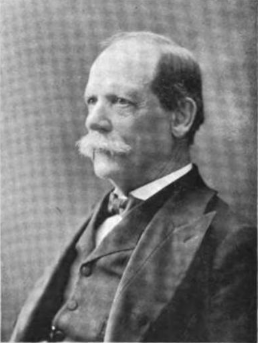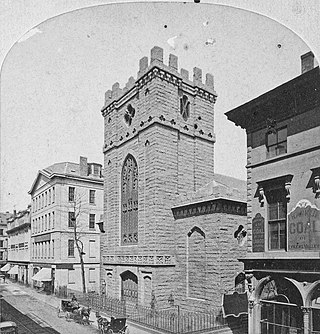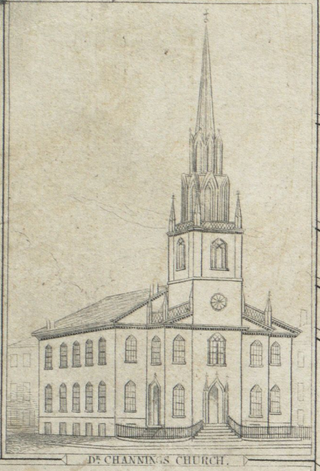
The Hollis Street Church (1732 - 1887) in Boston, Massachusetts, was a Congregational (1732 - c. 1800) and Unitarian (c. 1800 - 1887) church. It merged with the South Congregational Society of Boston in 1887.

The Hollis Street Church (1732 - 1887) in Boston, Massachusetts, was a Congregational (1732 - c. 1800) and Unitarian (c. 1800 - 1887) church. It merged with the South Congregational Society of Boston in 1887.
In the early years of the church, pew-holders included Benjamin Church, Caleb Davis, and Benjamin West. A fire in 1787 destroyed the church building. [1] [2] Architect Charles Bulfinch designed the replacement in 1788.
In 1810–1811, a brick building replaced Bulfinch's wood structure. "The wooden age yields to the brick; comfort now aspires to elegance." [3] The old Bulfinch building "was purchased by the Union Religious Society of Braintree and Weymouth, ... taken down piece by piece, floated on a raft to Braintree and rebuilt on Quincy Ave near Commercial St. next to the railroad tracks. The church design was slightly altered and a new bell, forged by Paul Revere, was placed in the clock tower. First services were held in the church in November 1810." [4]

By 1825, some of the congregation sought to create another church to alleviate overcrowding, and so established the South Congregational Society. [5] In 1883-1884 the church congregation erected a new building in the Back Bay area of Boston, on Newbury Street at Exeter Street. It was designed by architect George Meacham. Ministers included Edward Everett Hale. In 1887 the New Hollis Street Church congregation joined the South Congregational Society, which in 1925 merged with the First Church of Boston. [6] The old Hollis Street building was sold, and later the site became the Hollis Street Theatre. [7]

Charles Bulfinch was an early American architect, and has been regarded by many as the first American-born professional architect to practice.

The Old North Church, is an Episcopal mission church located in the North End neighborhood of Boston. The church, which was built in 1723, is the oldest standing church building in Boston and a National Historic Landmark.

The Old South Meeting House is a historic Congregational church building located at the corner of Milk and Washington Streets in the Downtown Crossing area of Boston, Massachusetts, built in 1729. It gained fame as the organizing point for the Boston Tea Party on December 16, 1773. Five thousand or more colonists gathered at the Meeting House, the largest building in Boston at the time.

Mather Byles was an American clergyman active in British North America.
Bowdoin Street in Boston, Massachusetts, extends from the top of Beacon Street, down Beacon Hill to Cambridge Street, near the West End. It was originally called "Middlecott Street" as early as the 1750s. In 1805 it was renamed after the Governor James Bowdoin.

Leonard Woolsey Bacon was an American clergyman, born in New Haven, Connecticut. He was a social commentator and a prolific author on religious, social, and historical matters. In social, political, and religious issues of his times, he often broke with the traditions of his countrymen, sometimes causing "great sensation."

The Church of the Holy Cross (1803-ca.1862) was located on Franklin Street in Boston, Massachusetts. In 1808 the church became the Cathedral of the Holy Cross. It was designed by Charles Bulfinch and was the first church built for the city's Roman Catholics.

First Church in Boston is a Unitarian Universalist Church founded in 1630 by John Winthrop's original Puritan settlement in Boston, Massachusetts. The current building, located on 66 Marlborough Street in the Back Bay neighborhood, was designed by Paul Rudolph in a modernist style after a fire in 1968. It incorporates part of the earlier gothic revival building designed by William Robert Ware and Henry Van Brunt in 1867. The church has long been associated with Harvard University.

The Unitarian Universalist Church of Medford and The Osgood House are a historic Unitarian Universalist church building and parsonage house at 141 and 147 High Street in Medford, Massachusetts.

The Hollis Street Theatre (1885–1935) was a theatre in Boston, Massachusetts, that presented dramatic plays, opera, musical concerts, and other entertainments.

The Brattle Street Church (1698–1876) was a Congregational and Unitarian church on Brattle Street in Boston, Massachusetts.

Trinity Church (1735–1872) was an Episcopal church in Boston, Massachusetts, located on Summer Street. It housed Boston's third Anglican congregation. The Great Fire of 1872 destroyed the church building, and by 1877 the congregation moved into a new building in Back Bay.

Boylston Market (1810-1887), designed by architect Charles Bulfinch, was located in Boston, Massachusetts, on the corner of Boylston and Washington Streets. Boylston Hall occupied the third floor of the building, and functioned as a performance and meeting space.

New South Church (1714-1866) was a Congregational Unitarian church of the "New South Society" in Boston, Massachusetts, located on "Church Green" at the corner of Summer Street and Bedford Street. Pastors included Samuel Checkley and John Thornton Kirkland. In 1814 architect Charles Bulfinch designed a new building for the society; it was demolished in 1868. The congregation merged with the New South Free Church in 1866.

The Federal Street Church was a congregational Unitarian church in Boston, Massachusetts. Organized in 1727, the originally Presbyterian congregation changed in 1786 to "Congregationalism", then adopted the liberal theology of its fifth Senior Minister, William Ellery Channing, (1780–1842). For most of the 18th century the church was known as the Long Lane Meeting-House. In 1788, state leaders met in the relatively spacious building to determine Massachusetts' ratification of the United States Constitution. Thereafter the church renamed itself the Federal Street Church in honor of the event. In 1803, it called Channing as its minister who defined "Unitarian Christianity" and launched the Unitarian movement, making the Federal Street Church one of the first to define itself as Unitarian.

Cummings and Sears was an architecture firm in 19th-century Boston, Massachusetts, established by Charles Amos Cummings and Willard T. Sears.

First Unitarian Church of Providence is an American Unitarian Universalist congregation located at the corner of Benefit and Benevolent Streets in Providence, Rhode Island. The congregation was founded in 1723, and the current church building was dedicated in 1816. For many years it was known as the First Congregational Church of Providence.

Rev. John Seccombe was an author, a founder of Chester, Nova Scotia and was “the best-known and most highly respected clergyman in Nova Scotia.” He was also the author of Father Abbey's Will, which was printed as a poem and a broadsheet over 30 times throughout the 18th century in England and America. According to the Manual of American Literature, the poem "was one of the best comic poems of that day." As a result of the poem, the History of American Literature indicated that Seccombe "had an extraordinary notoriety" in America's early literary history.

George Leonard Chaney (1836-1922) was a Boston Unitarian minister who served the city’s Hollis Street Church for 15 years. In 1882, at the American Unitarian Association's (A.U.A.) request, he moved to Atlanta to organize the first Unitarian church in that city. As the A.U.A. Southern Superintendent, he was a leader in expanding Unitarianism across the South. He later moved to Richmond, Virginia and established another Unitarian church. In 1895, he retired from his superintendent and ministerial duties and returned to Massachusetts.